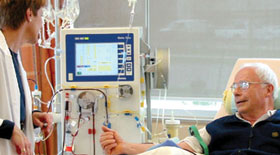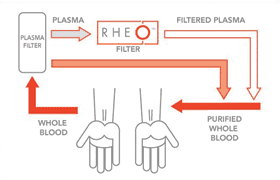Rheopheresis moves closer to FDA approval, availability in U.S.
Click Here to Manage Email Alerts
Currently one of the most promising treatments for dry age-related macular degeneration, Rheopheresis continues to yield encouraging results in ongoing clinical trials. Today the procedure is available only in Canada and Europe, but it continues to move steadily toward approval by the U.S. Food and Drug Administration.
According to David Eldridge, OD, FAAO, vice president of science and technology for Occulogix Inc., Rheopheresis is a trademark name that describes a therapeutic apheresis procedure. Dr. Eldridge provided Primary Care Optometry News with an update on the clinical trial progress. “We closed enrollment in December 2004 and are in the process of completing the final follow-up visits of the last enrollees,” he said in an interview.
MIRA-1, LEARN studies
Dr. Eldridge said the Multicenter Investigation of Rheopheresis for AMD (MIRA-1) trial is expected to be completed by December 2005. “Our plan is to submit our PMA [pre-market approval application] to the FDA in the first quarter of 2006, which we hope will lead to approval in late 2006 here in the United States,” Dr. Eldridge said.
|
|
The MIRA-1 is a randomized, prospective, multicenter, double-masked, placebo trial to compare Rheopheresis therapy against placebo in 150 patients, according to the study protocol. Dr. Eldridge noted that because the technology is a “device” and not a “drug,” smaller numbers of patients are required for approval.
To qualify for the trial, study eyes were required to have a diagnosis of nonexudative “dry” AMD with soft, semi-soft or confluent drusen, according to a Web site for the MIRA-1 trial. Subjects were required to have elevated baseline concentrations of two of the following three rheologic factors: a total serum cholesterol level of 200 mg/dL or more, a serum fibrinogen level of 300 mg/dL or more or a serum immunoglobulin A (IgA) level of 200 mg/dL or more.
The study protocol specified that each patient was to receive either eight treatments or placebo procedures over a 10- to 12-week period; they were randomized to the treatment or placebo groups 2:1, respectively. Patients would be seen at 3, 6, 9 and 12 months.
By December 2004, 185 patients had been enrolled in the trial, said Dr. Eldridge. Treatments were completed in February 2005, with a 12-month follow-up completion scheduled for December 2005.
Also currently underway is the Long-term Efficacy in AMD from Rheopheresis in North America (LEARN) trial, which is a crossover FDA study of patients receiving booster treatments, Dr. Eldridge said. This trial also involves placebo patients receiving the full eight treatments over 10 to 12 weeks, and both arms of the cohort are followed for another 12 months.
Trials in Canada
|
|
Dr. Eldridge also discussed the Prospective Evaluation of Rheopheresis in Canada trial for AMD in Canada (PERC) open-label study. In this study led by David Wong, MD, dry AMD patients were treated with Rheopheresis following the MIRA protocol. However, there was one important exclusion, Dr. Eldridge said.
“We did not require patients to have laboratory findings of elevation of the two or three macromolecule markers that we required in MIRA,” he said. “The results seem to be very consistent with those seen in the interim analysis that was published on the first 33% of our cohort, with complete 12-month follow-up.”
According to a presentation Dr. David Boyer, principal investigator for MIRA-1, made at the American Society of Retinal Specialists meeting in July, the study prospectively looked at 30 eyes at a single center. Of these eyes, 93% maintained the same visual acuity as baseline or improved at 18 weeks.
Ten percent (three) eyes gained three or more lines, 10% gained at least two but less than three lines. A total of 20% (six eyes) gained at least one line but less than two lines. Ten percent improved, but less than one line. Thirteen eyes (43%) lost no letters or showed no improvement.
A recent article by Jose S. Pulido, MD, proposed a mechanism of action for development of AMD and the use of Rheopheresis for AMD treatment. Published in the June 2005 issue of the Canadian Journal of Ophthalmology, the study reviewed existing literature regarding AMD and Rheopheresis. In particular, the article gleaned data that might support the use of Rheopheresis in treating the pathophysiology of AMD.
According to the peer-reviewed article, AMD may be characterized by an accumulation of cross-linked proteins called advanced macular oxidation products (AMOPS) and a combination of diffusion/deposition processes along with permeability and inflammatory changes. The hypothesis is that Rheopheresis results in the removal of uncross-linked proteins, allowing for antioxidant entry into Bruch’s membrane, which stops further accumulation of AMOPs.
RheoNet registry tracks data
Dr. Eldridge also discussed the RheoNet Registry, which collects Rheopheresis data and is regularly updated. The registry’s stated goal is to “report on data to help determine a real-time incidence of adverse events and visual events that occur during Rheopheresis treatments.”
The most recent update to the registry included ophthalmologic data of 194 eyes of 135 AMD patients. These patients had dry AMD, with visual acuity of more than 0.1. Patients received a mean of 8.7 Rheopheresis treatments. According to an abstract, Rheopheresis treatment resulted in an ETDRS-VA improvement of +0.82 lines compared to baseline.
Target population
According to Dr. Eldridge, these studies primarily included patients with dry AMD classified as Category 3 and 4 in the Age-Related Eye Disease Study (AREDS) report. This is the target population for Rheopheresis treatment, he said.
“These are the high-risk, dry AMD patients who have significant risk of converting to wet AMD, along with further deterioration of best-corrected visual acuity from dry progression,” he said. “Patients treated have best-corrected visual acuities between 20/32 and 20/125, with 10 or more moderate to soft drusen in the macula.”
He said most patients in the trials mirror the average patient suffering from dry AMD: between 50 and 85 years old and without significant heart disease, blood disease or cancer.
“Epidemiology studies have confirmed, and we have seen in our research, that patients having elevated cholesterol and other large protein molecules in their blood are at significant risk to develop AMD,” Dr. Eldridge said.
Providing technology
Dr. Eldridge said although TLC Vision is an investor in OccuLogix Inc., the company will not be in the centers business. “We at OccuLogix want to work with all doctors and facilities to bring Rheopheresis to the thousands of patients who need the treatment,” he said.
Dr. Eldridge compared the role of OccuLogix to that of Alcon or Visx in the laser vision correction realm. “We will provide the technology to whomever wishes to offer it to patients,” he said.
The board of TLC decided to fund OccuLogix, formerly Vascular Sciences, to facilitate the continuation of the FDA trial. Vascular Sciences went public on NASDAQ in December 2004 under the name OccuLogix Inc.
“TLC has not yet decided if it wants to be in the provider business for Rheopheresis, as it is so different from its current laser operations,” Dr. Eldridge said. “While that may happen in the future, today TLC involvement is simply one of financial interest as a large shareholder.”
OccuLogix anticipates FDA approval for Rheopheresis next year, said Dr. Eldridge.
For Your Information:
- David Eldridge, OD, FAAO, is vice president of science and technology for Occulogix Inc. He can be reached at 6603 112th Street, Bixby, OK 74008-2050; (918) 361-8152; fax (918) 299-7443; e-mail: david.eldridge@occulogix.com.
- OccuLogix Inc., based in Toronto, can be reached at (877) AMD-EYES or www.rheo.com.

![David Eldridge, OD, FAAO [photo]](/~/media/images/news/print/primary-care-optometry-news/2005/11_november/eldridge_70_90_75508.jpg)

